Verdict
Even with a top-notch screen at an attractive aspect ratio, the Xperia 10 V forgets what is keeping other budget phones in our hands years after purchase. This is one that feels sluggish out of the box, with its old trick of relying on its camera not really carrying the weight in the face of fierce competition. Commuting movie buffs might get a kick out of the screen, but that’s about it.
Pros
- Decent camera with plenty of pro controls
- 21:9 OLED screen is great for movies
- Timeless design
Cons
- Sluggish processor
- 60Hz refresh rate
-
Two-day battery lifeThe 5000mAh battery delivers comfortable battery life, up to two days if you don’t push it too hard. -
Sony audio DACWith a dedicated 3.5mm headphone jack and audio DAC, the Xperia 10 V excels at good old-fashioned wired playback. -
21:9 OLED displayThe 21:9 aspect ratio makes the Xperia 10 V’s display ideal for ultrawide Hollywood blockbusters, showcasing movies without any kind of black bars atop or below.
Introduction
Once revered for its high-end devices, Sony has pulled its mobile division back in recent years in the face of fierce competition and shrinking market shares.
You can still get its top-tier devices like the Xperia 1 V. That hasn’t changed. But they’re a growing niche these days, typically being announced long before their street date and only taken on by its most adoring fans.
But its budget smartphones are still kicking around. At first look, you’d struggle to tell them apart, with most of the big differences being under the hood where only enthusiasts tend to look. And a couple of years ago, that was good. Smart, even.
Nowadays, however, Sony’s budget blocks are starting to struggle to stand out. Again. And the Xperia 10 V is a prime example of the Japanese electronics giant potentially overthinking things.
It’s a gorgeous device, but rather than feeling like a spry, energetic youngster ready to take on the world, pulling it out of the box feels like a metaphor for hoisting a senior citizen out of their favourite chair to take them for a walk they just don’t want.
Design
- Durable all-plastic build
- IP65/68 dust and water resistance
- Beautiful colour choices
Even as soon as I bought my, what was then, brand-new Google Pixel 2 XL, I remember being enamoured by a friend’s tiny Sony Xperia smartphone. Jealous, almost. Its smooth and stylish chocolate block design just looked right. And it felt right.
Once again, the Sony design team are on point with the Xperia 10 V. Even if they’re simply following the principles set by the Xperia brand team in a figurative bygone era, there’s still an air of sophistication and timelessness about it.
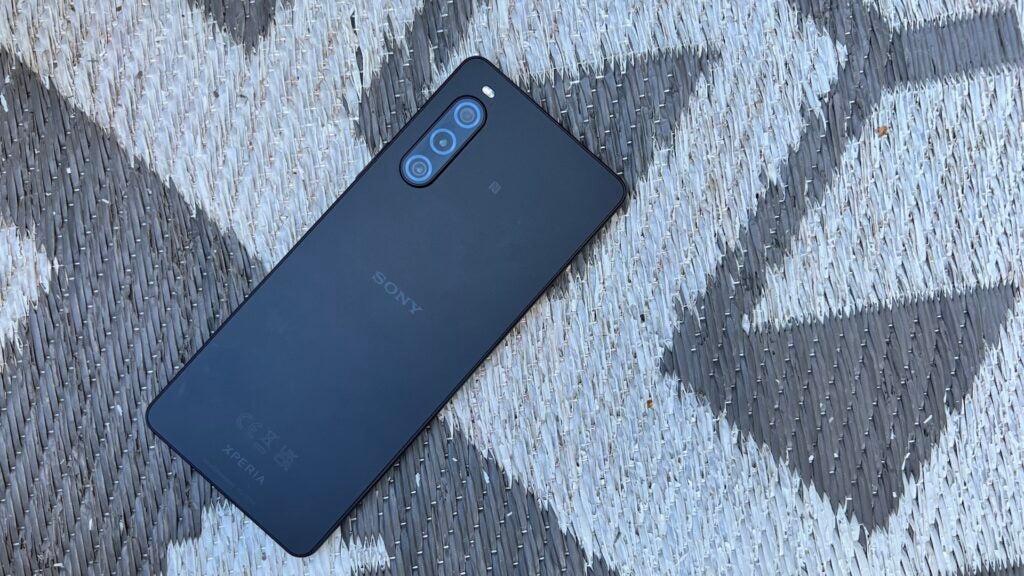
The smooth sides, generously rounded edges, and chocolate bar shape of the tall and slender device are incredibly easy on the eyes.
Though I tested it in its safe and standard black, it’s available in soft and playful blue, green, and white options, which could actually go a long way in enticing those who like a pop of colour to show off some personality.
Though I wouldn’t trust it to not slide out of my pocket on a bike ride, the mostly plastic build would likely hold up well to an accidental bump, scrape, or slam unlike a glass-backed device, and IP65/68 dust and water resistance is basically unheard of at this price point, delivering added peace of mind.
The fact that it still looks premium without following the trends of glass and shimmery rear paint jobs can’t be ignored either.
Screen
- 6.1-inch OLED screen
- Great outdoor viewing
- 21:9 aspect ratio
What likely wouldn’t survive a fall, however, is the screen. That shouldn’t come as a surprise. The Xperia 10 V packs a brilliant OLED panel into its uniquely-tall chassis, affording it the 21:9 aspect ratio Sony is still relying on to peddle its devices as superior cinephile setups. Martin Scorsese, your crusade against watching Goodfellas in a supermarket car park is over.
Likely using it as a way to sell folks on watching its own movies without the black bars, it’s a great idea on paper, but it leads to excessive pillarboxing when binging boxsets. Filling to zoom, which is something I do with less serious YouTube videos on devices that stick closer to traditional 16:9 widescreen, cuts off too much content to be worth it, leaving plenty of screen real estate wasted.
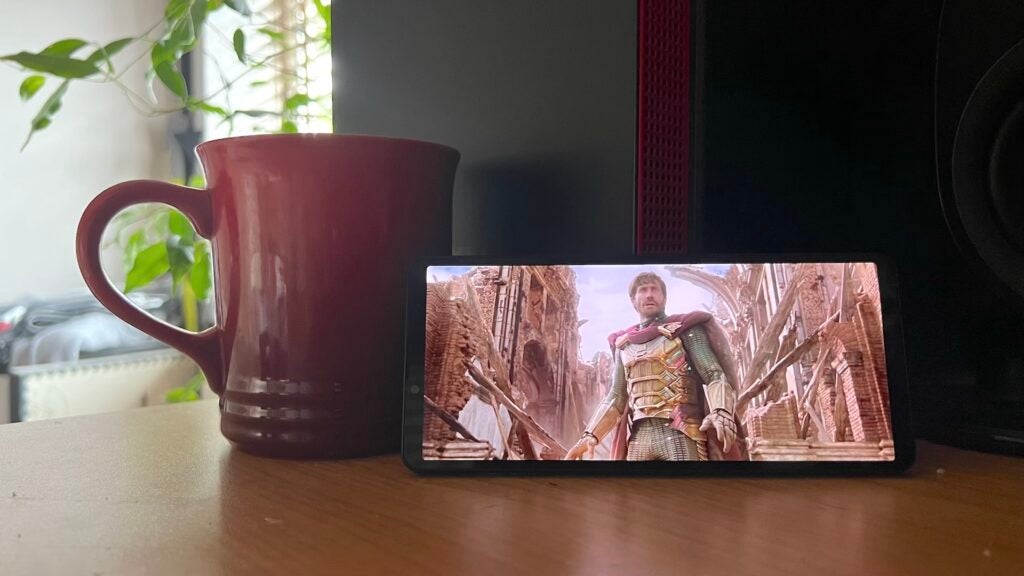
Although the slimmer shape of the screen makes reaching the other side easy with your thumb in standard portrait mode when scrolling the web or social media, the expanded nature of it means reaching up for things like notifications requires extra effort as well.
It’s great for multitasking, which could suit the aforementioned premium and professional look of Xperia devices as a whole, but at the budget price bracket, it feels at odds with how likely customers tend to use their devices. Sure, you might be able to squeeze an extra social post in before having to scroll again, but is it worth the constant inconveniences? Not personally, no.
Practicality concerns aside, the OLED panel in the Xperia 10 V is a joy when fully utilized. Multitasking has the space it needs to make proper sense, and the inherent colour profiling of the tech means HDR photos and movies really pop.
If you do watch a lot of big-budget movies on the go, you’ll absolutely love the expanded view you won’t get on your TV. And just as it gets easily bright enough for brilliant outdoor viewing, it gets dim enough to enjoy in bed too without losing much of its warmth. It’s just a shame that it’s stuck at the ageing 60Hz refresh rate when so much of the competition has made the jump to 90– or 120Hz.
Camera
- 48MP parimary camera
- 2x telephoto and ultrawide secondary lenses
- Detailed Pro mode
For years now, Sony has attempted to market its phones as great entryways into the world of professional digital photography: a way to teach and inspire and eventually upsell to a proper DLSR or mirrorless frame with a familiar UI structure.
It’s a solid idea for a company whose cameras are typically revered and recommended across not only the photography space, but the rapidly growing vlogging and streaming market, too.
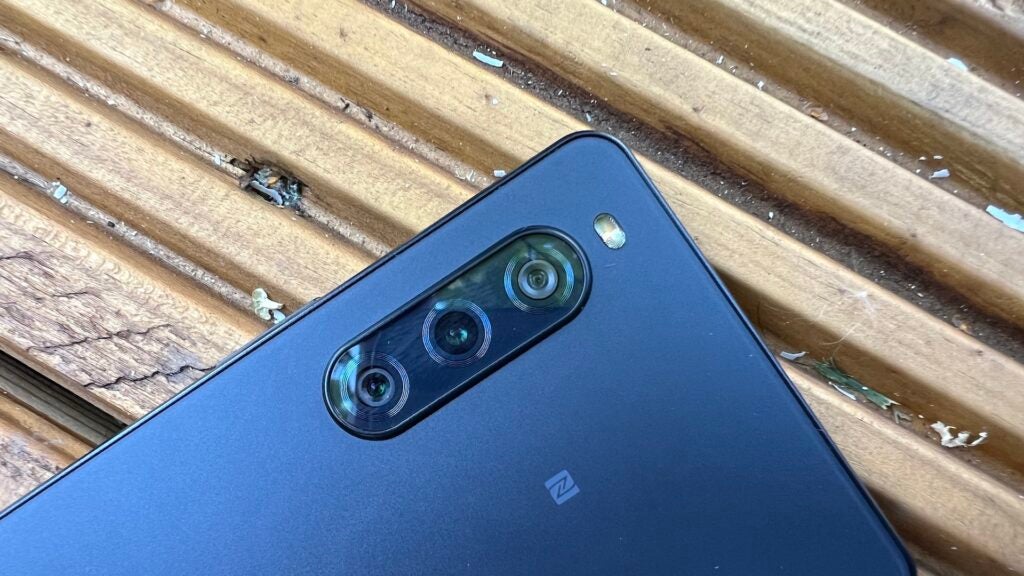
And, just like the rest, the Xperia 10 V follows in the footsteps of its siblings, front-loading a relatively simple point-and-shoot camera app that includes a curious button into a much more complicated interface designed to get you hooked on manual controls.
In the standard Camera app, getting a great shot isn’t hard. It’s point-and-shoot as you’d expect, with all three of the lenses (a rare sight in a budget phone) delivering solid results when lined up correctly. I took it on a 10-mile bike ride through towns and a local park along the canal, snapping wide-angle shots of the lake and its feathered friends. At home, I made my usual backyard ornaments my subjects.
Though I was pleasantly surprised by the sharpness of each image, colours under artificial light indoors came out a little cold. Not so severe as to be unworkable with a bit of editing magic, but sending a shot of a boho dining table in a store to send back to my partner over Discord didn’t quite accurately convey what I was seeing in person.
Getting motion shots, however, was a whole other story. Without hopping into manual mode to increase the shutter speed, relying on the basic camera app to snap a cute shot of a subject that won’t sit still always felt like an impossible mission.
My dachshund slowly trudging through the grass was just slow enough to not completely blur out, but the noticeable delay between pressing the shutter button and the photo actually saving (before processing) is frankly disappointing, and likely another example of how much the sub-par processor in the Xperia 10 V actually holds back the experience.
I don’t doubt that you’ll be able to get some great shots via the camera app’s manual controls with enough effort. But when outside video on a summer’s day came out looking noisy, processed, and bumpy, there are doubts that the vast majority of casual snappers will feel a little burned by Sony’s usually solid reputation in the photography field.
Performance
- Snapdragon 695 5G chipset
- 6GB RAM
- Sluggish performance
Externally, the Sony Xperia V 10 is a delight. Internally, it’s drab. The Snapdragon 695 5G chipset powering the whole operation just can’t keep up like some other top-tier phones in its mid-range price bracket can.
When you can get more from the Samsung Galaxy A54 5G with a plethora of quirky features or shown the door by the Google Pixel 7a and its more easily enjoyable camera, things are bound to go south quickly.
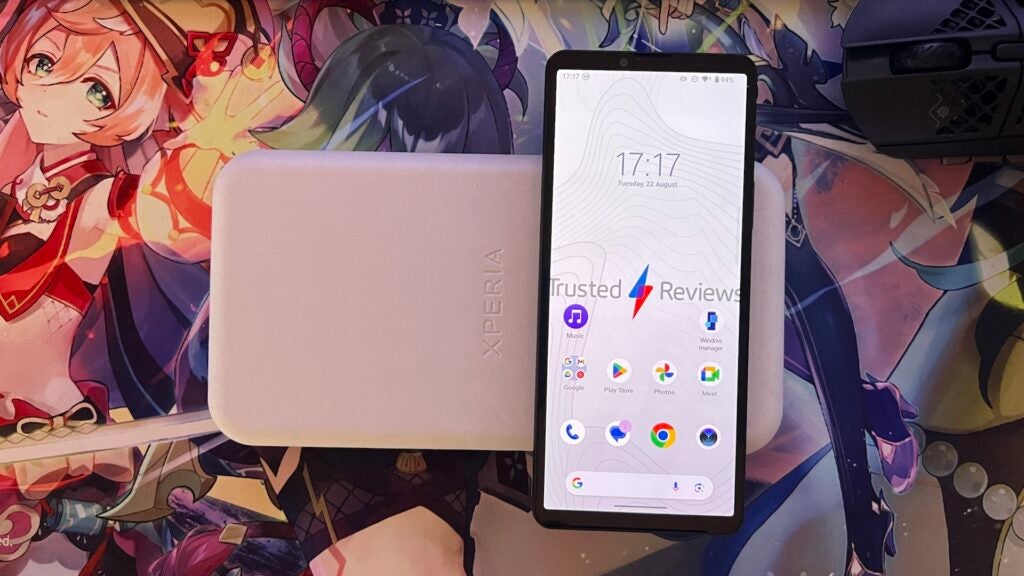
As soon as I got set up, it was immediately clear that I wouldn’t be getting a whole lot out of it. So long as you’re not into playing graphically intensive 3D games like Honkai Star Rail, you won’t notice things quite so starkly as I did. But that doesn’t make day-to-day operations silky smooth, either.
Beyond the obvious home screen stuttering that would have made a smoother screen meaningless anyway, there were numerous times the Camera app couldn’t even keep up. Images would often take over a second to capture, making those blink-and-you-’ll-miss-it moments impossible to grab, and the Camera app would frequently crash back to the home screen wholesale – as would other apps.
Between a relatively small 6GB memory allowance to a chip that’s battered by others in the same price bracket, the Xperia 10 V can’t help but feel sluggish right out of the gate. For the price, there are infinitely stronger mid-range devices, making the taller OLED screen and its devilishly good looks the sole selling points with this one.
Software
- Little to no bloatware
- Signature camera app
- Poor long-term software support
When it comes to included software and services, there isn’t a massive amount to talk about with the Xperia 10 V.
Like any Xperia, the standout app comes in the form of the camera’s hidden Pro mode. Though the bog-standard one has a couple more buttons and icons than most to tempt you away from the path of point-and-shoot photography, the Pro mode always watching in the corner can be quickly toggled to get much of the same manual control over your shots as you would with a proper DSLR frame.
It would have been nice to see Sony take it a step further with some sort of tutorial on its features or a full-blown photography course baked right in. Then again, it’s intuitive enough to mostly work out for yourself. Icons for things like shutter speed are shown as a slider capturing still or fast-moving subjects, with the image preview on the viewfinder changing in perceived brightness to illustrate the amount of light the final shot would actually take in.
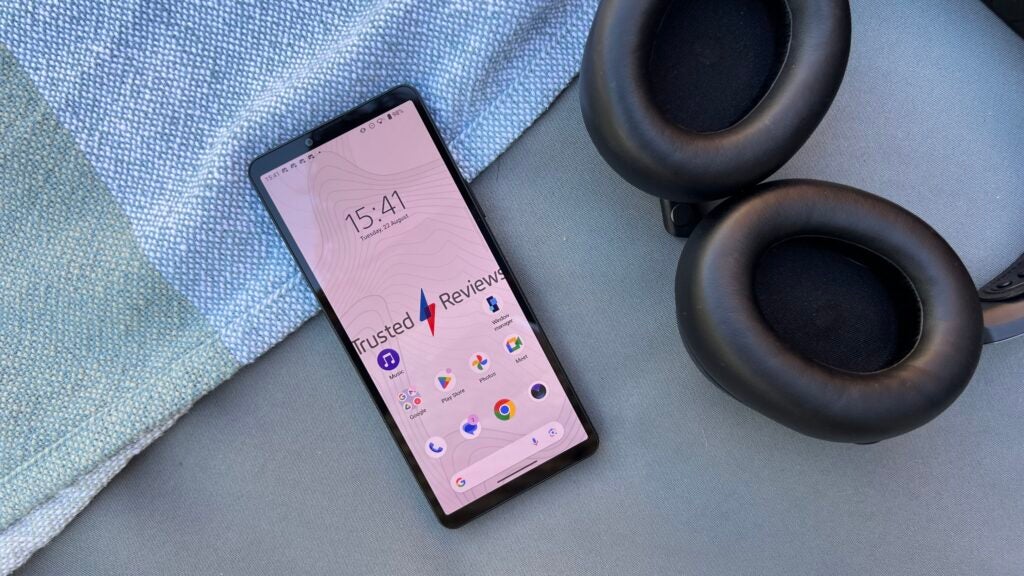
Everything’s simplified in a more intuitive way, which should go a long way in encouraging experimentation.
In general use, Sony has elected to utilize a sneaky little side window you’ll vaguely see as a tiny transparent rectangle on the upper portion of the screen’s right side.
A double tap of the thin buffer pops out a multitasking menu. It’s a little fiddly compared to some other solutions, but between two tabs and a bunch of common apps, you just hold and drag your desired one into the split area beneath. Tapping it then launches it in a half-view window beneath your current one.
To help facilitate building up a layout of common apps you use specifically in landscape rather than portrait view, you can slide over to the 21:9 tab to configure your favourites there, too.
The big disappointment here is long-term support, with Sony only delivering one OS upgrade for the Xperia 10 V. Compared to the likes of the Pixel 7a and Galaxy A54 5G with multi-year OS upgrades, it’s shockingly limited.
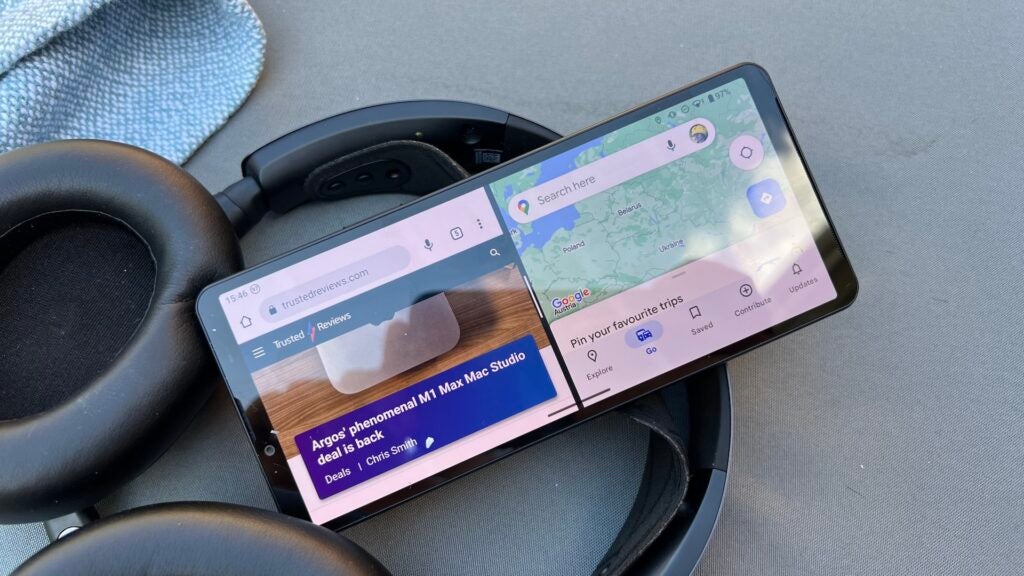
Battery life
- 5000mAh capacity
- Two-day battery
- Wireless charging
Following the trend of not shipping with a charger, the Xperia 10 V’s battery performance is going to be at the whim of the plug you hook it up to. To a point, at least.
Hooked up to a high-wattage GaN charger, Sony’s low-end effort didn’t juice up particularly quickly, feeling, again, a little like a relic of a bygone time compared to the fast-charging competition out there. A 15-minute resuscitation session saw it gain 17%, accurately managing to suck up 34% total in 30 minutes.
Charging from 0% on the same charger, it reached 50% in 48 minutes, capping out at 100% in just a hair under two hours. You’ll likely want to leave it an hour longer to get the most out of the battery, but the evidence backs up the spec sheet, proving the Xperia 10 V isn’t really equipped to take in today’s fast-charging power bricks.
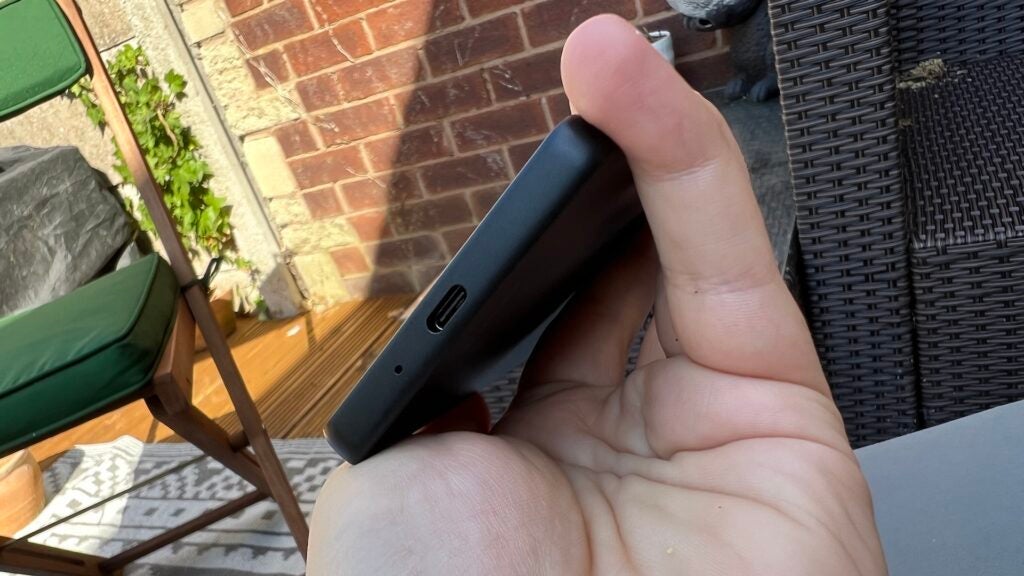
That means your standard adaptor lying around won’t really need upgrading, giving a point to the “green” practice of simply using what you already have, but it’s another case of Sony’s handset struggling to keep up with the truly convenient features of the phones it’s trying to compete with for the same money.
On the plus side, the battery puts up a decent enough fight.
Likely due to the underpowered processor and sluggish (by today’s standards) screen, you’ll get satisfactory mileage from this one. Even with a bit of light gaming and YouTube, we managed two days of comfortable use. Hook it up overnight on that second sleep and you’ll have no problems if you’re prone to forgetting to top-up when you’re in the shower or at your desk.
Should you buy it?
You want something a little different: Between larger movies and better multitasking efforts, the 21:9 screen can change the way you use your device.
Final Thoughts
Although the 21:9 OLED panel can make movies and multitasking a joy to behold, almost everything else about the Xperia 10 V feels a little too old for a brand-new phone.
Compared to the Pixel 7a, Samsung Galaxy A54 5G, or even the lightning-fast Poco F5, you can get a lot more for not a lot more, be it more processing power, faster charging or better long-term software support.
It’s a beautiful device, but unless you’re just trying to stand out and keep things simple, spending a little extra on your mid-ranger will likely save you the cost of an upgrade in a year’s time.
FAQs
No, there’s no wireless charging with the Xperia 10 V.
You can hook up to the Xperia 10 V’s dedicated DAC via the 3.5mm jack on the top.
You can pick up an official 30W charger or a case with a landscape kickstand for video directly from Sony.
Jargon buster
mAh
An abbreviation for milliampere-hour and a way to express the capacity of batteries, especially smaller ones in phones. In most cases the higher the mAh, the longer the battery will last but this isn’t always the case.
IP rating
An abbreviation for ‘Ingress Protection Code’, which lets you know to what extent a device might be waterproof or dustproof.
















